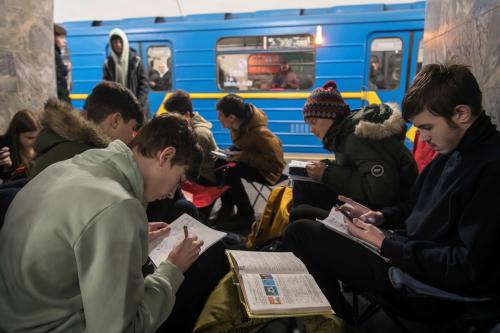If anyone needs another reminder of how minimal Americans’ understanding of and access to Iran has become, the discourse in Washington over the past week certainly provides one. As scenes of Iranian bravery and bloodshed have unfolded, American pundits and politicians have fixated on President Obama’s syntax and inflection. Although a passing familiarity with Iranian history, as well as Iranians’ appeals for Washington not to meddle in their nascent movement, buttress the case for caution, the tempest over presidential semantics is at best a pointless exercise and at worst a distraction from the serious question ahead: How will Iran’s internal crisis will impact U.S. policy?
The fact is, no matter how much Americans like to think they are the ones shaping events in Iran, it’s just not true. The dramatic events in Iran have been wholly internally driven. They are the product of three decades of semi-competitive Iranian elections, a sophisticated population that warily guards its limited rights and freedoms, the tensions of a longstanding elite power struggle, and the ever-important force of unintended consequences — among other factors. Better for the United States, then, to focus on those areas where it actually has some capacity for influence: namely, its own Iran policy, and more specifically, how Washington can move forward with engaging Tehran in light of the dramatic changes of the past 10 days.
As profound as recent events have been, engagement remains the only path forward for Washington. Whenever the dust settles in the tumultuous battle on the streets and behind the scenes, direct U.S. diplomacy continues to represent the most viable mechanism for addressing Iran’s nuclear ambitions. After all, Obama’s interest in engagement was never about the Iranian leadership, and until very recently, most experts expected a second Ahmadinejad term. Instead, the case for engagement was – and still is – rooted in the urgency of the world’s concerns about Iran’s ambitions and the even-less promising U.S. policy alternatives, such as military action or externally sponsored regime change.
Even if the upheaval in Iran does not inherently alter the rationale for engagement, however, it will likely exacerbate the potential pitfalls of implementing it. One line the administration is floating on engagement now — that the consolidation of power under Iranian hard-liners will create incentives for a quick resolution of the nuclear standoff — is certainly conceivable. But given Tehran’s uncompromising rhetoric and recent resort to violence, this argument sounds suspiciously like wishful thinking. More likely, the United States is going to have to deal with an increasingly paranoid and dogmatic Iranian regime, which is preoccupied by a low-level popular insurgency and a schism among its longstanding power brokers.
This begs a lot of questions, foremost of which is: How can Washington get an even more thuggish theocracy to make meaningful concessions and credible, durable commitments to its historical adversary when Iran’s own power structure is still shifting considerably? Fortunately, this is not an insurmountable hurdle, and a little history can help us clear it.
From 1980-81, the United States conducted hard-headed diplomacy with a revolutionary government in Iran, when the country was still in a state of unrest, to secure the release of American hostages seized from the U.S. Embassy in Tehran in 1979. This challenge was at least as daunting as that of today. The Carter administration’s negotiators faced an array of implacably anti-American interlocutors whose authority, credibility, and interest in resolving the crisis remained an open question throughout the dialogue. Moreover, Tehran’s ultimate goals seemed unclear, possibly even unknown to its leaders, who often employed the negotiating process as a means of prolonging the crisis rather than resolving it.
An agreement to end the hostage crisis was ultimately reached. But it took months of intense work and many false starts, as well as a variety of tools, including secret negotiations and a third-party mediator and guarantor for the eventual agreement. Whether or not this kind of hard-won success can be replicated now is unclear. If anything, the stakes today are higher and the Iranian political dynamics are less promising, at least in the very short term. Still, charting a path forward for diplomacy is certainly the most constructive use of U.S. political capital and energy at this juncture.
But what about Iran’s burgeoning democracy movement? And what useful role can and should the United States can play in advancing it? Given recent events, it was inevitable that some American pundits and policymakers would renew their calls for additional U.S. democracy assistance programs for Iranian reformers. This would be precisely the wrong move – not because it would compromise the climate for nuclear negotiations, but because Iran’s own activists have consistently rejected such funding. They don’t want it, and elections-related news such as the massive reformist vote monitoring effort suggests they don’t need it. Better for Washington to focus efforts on where it can be both useful and welcome, such as last week’s timely intervention to encourage Twitter to defer network maintenance during a crucial moment of the protests.
The first chapter of Iran’s next great social movement has begun. Now it is time for Americans to put aside futile squabbling over the righteousness of their indignation and move on to more practical deliberations of where Iran and the United States go from here. In short, stop talking about talking and start talking with Iran.


Commentary
Op-edDiplomacy with Iran: The Show Must Go On
June 24, 2009